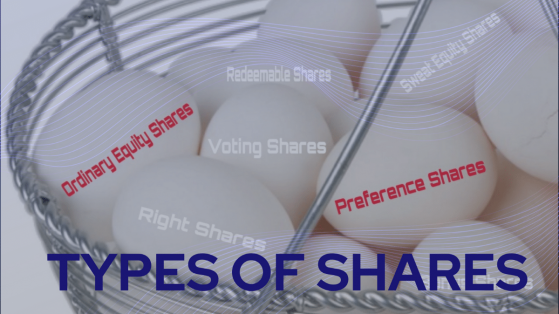Types of shares!! Does knowing this really help to become a successful investor?
What will be the difference on your investment if you know the types of shares?
Whether you are a beginner or have substantial investment experience, types of shares has more implications for both.
For your better understanding, I have tried to explain the types of shares in two ways. One from the company’s perspective and the other from the general investor perspective.
In this post you will read it from the perspective of the company.
Why are Types of Shares Important?
The knowledge of types of shares develop a sense of diversification in your investments as it is always advised by market experts.
It also helps you understand how a listed company operates in the stock market for its shareholders.
Let us know the types of shares in details today in reference to companies.
Actually shares are related to companies. So first of all know about the company.
What is a Company?
A company is a legal entity formed by a group of individuals to engage in and operate a business—commercial or industrial—enterprise. A company has many of the same legal rights and responsibilities as a person does, like the ability to enter into contracts, the right to sue (or be sued), borrow money, pay taxes, own assets, and hire employees.
Source: Investopedia
In simple words, a company is a type of business organization.
When a group of individuals wants to start a company, some legal procedures are followed as per the country’s rules.
Then that company is a private limited company. A private limited company has no right to sell its share in public.
Promoters– A group of individuals who have invested in the company from the first day to operate and run a company is known as a promoter.
Each promoter gets shares in the form of a share certificate in lieu of his own money invested in the company. To get shares, firstly, the members decide the face value of the company’s shares.
Face value– It is the actual price of a company’s stock at which shares are initially allocated to promoters of the company.
It is interesting to know that face value is decided only by the promoters of the company and not by any legal laws. Nowadays all the shares are credited in dematerialized form.
Suppose you start a company with four of your friends. Now you are all five who contribute equally. Suppose the investment amount of each is 2 lakh rupees.
Now the company has a total of one million rupees. And all of you have decided Rs 2 as the face value of the company.
A total of 5 lakh shares of your company will be issued and each member will get share certificate of 1 lakh shares in dematerialized form only now.
Transform into a Public Limited Company
Generally for a private limited company, there is a considerable time lag between a company starting its operations and issuing shares to the investing public.
A long time after the start of the company, a company realizes the need for more capital to expand its activities, production or services.
In such a situation a company will have to convert itself from a private limited company to a public limited company. Since only a public limited company has the right to sell its share in public.
Now the company will have two options – either becoming a listed public limited company or unlisted public limited company.
In either case, a public limited company can sell its shares publicly. But then the number of shareholders in an unlisted public company is countable.
But to collect large amount of capital, a company has to be listed on the stock exchanges. Every growing company has a status that ultimately has to be converted into a listed public limited company through the issuance of an IPO.
What are Shares in a Company?
I have already discussed about shares in the post “What is share market“.
In the Companies Act 2013, shares are defined as a measure of a shareholder’s interest in a company’s assets.
Equity Share Capital Meanings
Simply, a company has two main sources of capital funding – one from its promoters and the other from shareholders.
The initial capital received from shareholders by issuing stock through an IPO is called equity capital or equity share capital.
What are the Different Types of Shares
Shares are broadly classified into two types:
- Ordinary Equity Shares
- Preference Shares
Pro Tips: Since you are going to read about many different types of shares, this can be a bit confusing for you. Therefore you should pay more attention to the meaning of the name of the type of shares. This will help you understand the definition.
1. Ordinary Equity Shares
Ordinary equity shares are those stocks that you buy through an IPO or from a secondary market. It represents a form of fractional ownership in the company.
Highlights related to Ordinary Equity Shares –
- There is no guarantee of any dividend on Ordinary equity shares.
- Ordinary shareholders are considered to be the owners of the company. Therefore, they have the right over the remaining amount after paying the dues to all creditors and preference shareholders.
- Ordinary shareholders have the right to vote in all matters of the company.
- In the event of the company’s closure, these shareholders are the last to receive their claims.
- Ordinary shareholders are at greatest risk. But when the company makes good profit, its largest share goes to these shareholders. That is why the real benefit of investing in shares is found only in Ordinary equity shares.
- Ordinary shareholders also get rights shares and bonus shares from time to time from the company.
You can read about rights shares and bonus shares in the post ‘Types of Stocks to Invest in Terms of Common Investor’.
2. Preference shares
Preference means a prior right. And preference shares are also named in the same sense.
This share gives some preferential rights compared to Ordinary equity shares. Companies issue preference shares to their promoters and selected investors only.
Key points related to preference shares –
- The rate of dividend is fixed for preference shares at the time of issue.
- Regardless of the company’s losses or profits, preference shareholders always get the benefit of their fixed dividend.
- In the event of the company’s closure, preference shareholders have the first right to receive their claims.
- Preference shareholders usually have no voting rights.
Preference shares are further classified into four sub-categories:
Cumulative Preference Shares
Many times the company is unable to pay dividends to the preference shareholders if there is no profit. To avoid such situations, companies issue cumulative preference shares.
The dividends outstanding on these shares keep on accumulating instead of ending. And when the company has money, the last outstanding dividend is paid.
Non-cumulative Preference Shares
Non-cumulative shareholders do not receive any outstanding dividends. These shareholders are at greater risk.
Convertible Preference Shares
These are preference shares that can be converted into ordinary shares at a specified future date.
Cumulative Convertible Preference Shares (CCPs)
CCPs are shares that can be converted into equity shares in due course of time at a reasonable conversion price.
Differential Voting Right (DVR) shares
DVR shareholders have fewer voting rights than ordinary shareholders. To reduce voting privileges, companies offer additional dividends to DVR shareholders. Since DVR shares have less voting rights, their prices are also lower. There is a significant difference in the price of equity shares and DVR shares.
Conclusion
I tried to explain something about the company on the pretext of equity shares versus preference shares. Tell me about my effort.






